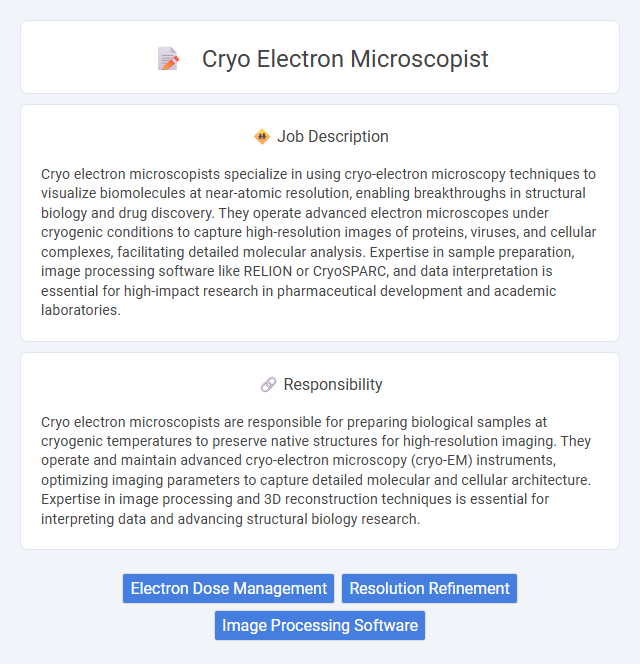
Cryo electron microscopists specialize in using cryo-electron microscopy techniques to visualize biomolecules at near-atomic resolution, enabling breakthroughs in structural biology and drug discovery. They operate advanced electron microscopes under cryogenic conditions to capture high-resolution images of proteins, viruses, and cellular complexes, facilitating detailed molecular analysis. Expertise in sample preparation, image processing software like RELION or CryoSPARC, and data interpretation is essential for high-impact research in pharmaceutical development and academic laboratories.
Individuals with strong attention to detail and patience are likely suitable for a Cryo electron microscopist role, as the job often requires meticulous sample preparation and image analysis. People who can maintain focus during long periods of microscope operation and handle physically demanding tasks may have a higher probability of success. Those prone to fatigue or discomfort in controlled environments might find the work challenging and less suitable.
Qualification
A Cryo-Electron Microscopist typically requires a Ph.D. in structural biology, biophysics, or related fields, with extensive experience in cryo-electron microscopy techniques and sample preparation. Proficiency in operating advanced electron microscopes, image processing software such as RELION or CryoSPARC, and strong analytical skills to interpret high-resolution molecular data are essential. Candidates with a strong background in protein structure analysis and a track record of conducting collaborative research in academic or industrial settings are highly preferred.
Responsibility
Cryo electron microscopists are responsible for preparing biological samples at cryogenic temperatures to preserve native structures for high-resolution imaging. They operate and maintain advanced cryo-electron microscopy (cryo-EM) instruments, optimizing imaging parameters to capture detailed molecular and cellular architecture. Expertise in image processing and 3D reconstruction techniques is essential for interpreting data and advancing structural biology research.
Benefit
A Cryo Electron Microscopist position likely offers the benefit of working with cutting-edge imaging technology, providing the opportunity to contribute to groundbreaking research in structural biology. The role may also benefit from collaborations with interdisciplinary teams, fostering professional growth and skill enhancement. There is a probable advantage of access to state-of-the-art facilities and resources that support high-precision data acquisition and analysis.
Challenge
Cryo electron microscopist roles likely involve the challenge of mastering intricate sample preparation techniques to preserve biological specimens at cryogenic temperatures without compromising structural integrity. The complexity of operating advanced electron microscopes and interpreting high-resolution images probably requires continuous learning and adaptation to evolving technologies. Managing data quality and overcoming imaging artifacts may pose persistent difficulties demanding precision and problem-solving skills.
Career Advancement
A Cryo Electron Microscopist specializing in high-resolution imaging of biomolecules can advance to senior research scientist or laboratory director roles by developing expertise in cryo-EM technology and data analysis. Mastery in software tools like RELION and deep understanding of sample preparation techniques significantly enhance opportunities for leadership in academic or pharmaceutical research settings. Continuous publication of impactful findings and collaboration on interdisciplinary projects propel career growth within the structural biology and drug discovery industries.
Key Terms
Electron Dose Management
Electron dose management is critical for cryo-electron microscopists to minimize radiation damage and preserve sample integrity during imaging. Precise control of electron dose ensures high-resolution data acquisition while preventing artifacts in sensitive biological specimens. Advanced techniques, such as low-dose imaging protocols and real-time dose monitoring, optimize electron exposure for accurate structural analysis.
Resolution Refinement
Cryo electron microscopists specialize in enhancing resolution refinement by optimizing imaging conditions and employing advanced computational algorithms to reconstruct high-quality three-dimensional structures of biomolecules. Their expertise in managing electron beam parameters and sample vitrification directly impacts the precision and clarity of molecular details captured at near-atomic resolution. Mastery of software such as RELION and cryoSPARC plays a crucial role in data processing and resolution enhancement in cryo-EM studies.
Image Processing Software
Cryo electron microscopists specialize in using advanced image processing software such as RELION, CryoSPARC, and EMAN2 to reconstruct high-resolution 3D structures from 2D cryo-EM images. Proficiency in these tools enables precise motion correction, particle picking, and 3D classification essential for accurate structural analysis at the molecular level. Expertise in GPU-accelerated computing and scripting languages like Python enhances optimization of workflow efficiency and data interpretation in structural biology research.
 kuljobs.com
kuljobs.com